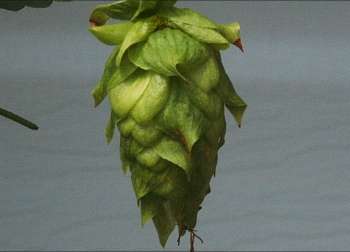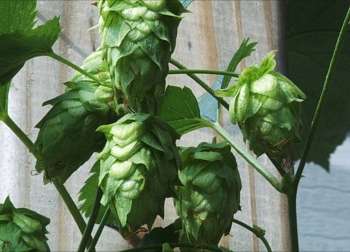- By Dan Segal, Owner of the Plantsmen Nursery
- Around Town
 Print
Print  Roughly a century ago, the vast majority of North America's hops was grown in Central New York. Today, few people even recognize the plant, despite its stellar combination of durability, quickness and unique charm. And since it's after nine p.m., I can also mention that hops is the vine whose flowers ('cones') are used in beer making.
Roughly a century ago, the vast majority of North America's hops was grown in Central New York. Today, few people even recognize the plant, despite its stellar combination of durability, quickness and unique charm. And since it's after nine p.m., I can also mention that hops is the vine whose flowers ('cones') are used in beer making.Hops is typically propagated by rhizomes, which are underground storage organs very similar to roots except that true roots don't sprout new stems the same way as rhizomes. A rhizome usually spreads out laterally underground, and when conditions are right, new stems arise vertically from the rhizome and pop out of the ground. The hops rhizome can be dug in fall, cut into smaller pieces, and then new plants can be grown from the pieces. Traditionally, hops vines were grown on oversized trellises, 20' or 24' tall, like gargantuan clotheslines.

Today, most people grow hops on arbors, chain link fences, home made trellises, decks, outhouses, fire escapes, old outbuildings, etc.--just that the commercial trellises are not seen much anymore. The flowers dangle from the vines in summer, and as they ripen, these can be tasted right off the vine. The flavor is exactly that of an IPA or any hoppy beer, for obvious reasons. But of course the flowers are not intoxicating at all, so you get the best of both worlds if you like beer--the flavor, concentrated, without the debilitating effects. You can pinch a flower, taste the hops, and keep right on working in the yard. A small nibble is best as the flowers are potent and pack a bite.

I have been referring to hops as "The Vine That Covers" in the nursery because so many of our nursery customers have been frustrated with Clematis, which could be dubbed "The Vine That Looks Good in Magazine Photos", or "The Vine That Might Do Better Next Year". Morning glories are also nice but are annuals, so unless they become established enough to return each year, you will feel that nagging biological clock that sends you out in May looking for potted morning glories, something that may not be easy to find.
Hops is perennial, so it returns each year, stronger and more vigorous each time. It's also deciduous, so it provides summer cover and shade, but doesn't grow a woody stem that can tear down a building over time, like Wisteria or trumpet vine. Give hops something to climb and it will stay in place. Otherwise, without support, it will wander until it finds some--not unlike most of us.
Happy Gardening!
----
v2i26



